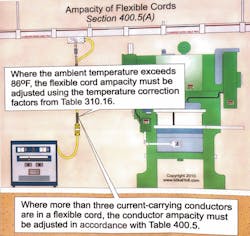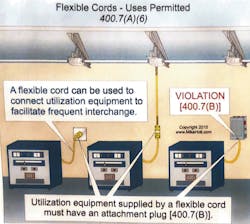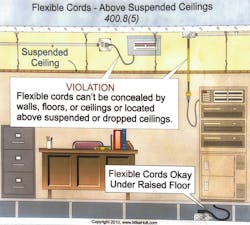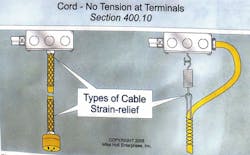Thank you for visiting one of our most popular classic articles. If you’d like to see updated information on this topic, please check out this recently published article, Flexible Cords and Flexible Cables. |
Flexible cords and cabling are very useful, allowing us to do things that Chapter 3 wiring methods do not. But this flexibility comes at a cost, and that cost is increased vulnerability. For that reason, Art. 400 requirements are essential for safety.
We can see the various types of flexible cords and cables in Table 400.4, which takes up seven pages and comprises more than half of Art. 400. The first rule of working with flexible cords and cables is always use that table. Some other basic rules to always keep in mind include:
- Always use a cord and fittings identified for the application [400.3].
- Never use a flexible cord or cable in place of a permanent wiring method.
- Replace, rather than patch, a damaged cord or cable.
Ampacity
Tables 400.5(A) and 400.5(B) list the allowable ampacity for flexible cords and flexible cables with not more than three current-carrying conductors at an ambient temperature of 86°F. The tables assume copper conductors.
- If the number of current-carrying conductors in a cable or raceway exceeds three, adjust the allowable ampacity of each conductor with the multipliers listed in Table 400.5.
- If the ambient temperature exceeds 86°F, the temperature correction factors listed in Table 310.16 are used to adjust the flexible cord or cable ampacity (Fig. 1).
Permitted uses
Wiring methods for flexible cords and cables aren't like those defined in Chapter 3. So, where can you use them? Per 400.7, you can use them in the following applications:
Banned uses
In 400.8, the NEC lists specific types of uses that are not permitted for flexible cords and cables [400.8]. Unless specifically allowed in 400.7, flexible cords must not be:
Some clarification is in order for the fifth bulleted item above. You can use flexible cords under a raised floor with removable panels used for environmental air, because this area isn't considered a concealed space. See the definition of "Exposed" in Art. 100.
You can install receptacles above suspended or dropped ceilings, but you can't install flexible cords up there to plug into them. So what's the point of installing the receptacle? The receptacle can supply power for portable lights and tools, but that receptacle can't be used to supply cord- and plug-connected equipment fastened in place, such as a permanently mounted projector.
Installation
Install flexible cords so tension, including that from the weight of the cord, won't be transmitted to the conductor terminals [400.10]. While the NEC allows you to accomplish this by knotting the cord or winding the cord with tape, it's best to use fittings designed for the purpose, such as strain-relief fittings (Fig. 4).
While you normally can't install flexible cords in raceways, there is a provision in the Code that allows cords inside raceways for a specific type of installation. In industrial establishments where the conditions of maintenance and supervision ensure that only qualified persons will service the installation, you can install flexible cords or flexible cables in aboveground raceways — but only if the cords/cables aren’t more than 50 ft long [400.14].
Overcurrent protection
Flexible cords and cables must be protected against overcurrent in accordance with 240.5, which contains the following requirements:
- Overcurrent devices must not be rated higher than the cord’s ampacity, as specified in Table 400.5(A) and Table 400.5(B) [240.5(A)].
- Flexible cord for listed utilization equipment is considered protected when used per the equipment listing requirements [240.5(B)(1)].
- Extension cord sets are considered protected when used per the extension cord listing requirements [240.5(B)(3)].
- Flexible cord used in field-assembled extension cords, made with separately listed and installed components, can be supplied by a 20A branch circuit for 16 AWG and larger conductors [240.5(B)(4)].
Conductor identification
How do you know which conductor in a cord is the neutral? It must be identified using one of the following methods [400.22]:
- White or gray colored braid.
- Colored tracer in the braid.
- White, gray, or light blue insulation.
- Ridges, grooves or white stripes on the exterior of the cord.
The equipment grounding conductor must be identified with one of the following methods [400.23]:
- Continuous green color.
- Continuous identifying marker distinguishing it from the other conductors.
If a conductor in a cord or cable has insulation that's green or green with one or more yellow stripes, don't use it for an ungrounded or neutral conductor [250.119].
Fixture wires
Fixture wires are flexible conductors used for wiring fixtures and control circuits, but not branch circuits. There are some special uses and requirements for fixture wires, and NEC Art. 402 deals especially with fixture wires. Some key points:
- No fixture wire can be smaller than 18 AWG [402.6].
- Fixture wires must be of a type listed in Table 402.3. That table makes up the bulk of Art. 402.
- The allowable ampacity of fixture wires is in Table 402.5.
Raceway size
Raceways must be large enough to permit the installation and removal of conductors without damaging conductor insulation [402.7]. The number of fixture wires permitted in a single raceway must not exceed the percentage fill specified in Table 1 of Chapter 9.
When all conductors in a raceway are the same size and insulation, you can use Annex C to determine the number of conductors permitted for the raceway type.
When all conductors are not of the same insulation type or the same size, then Chapter 9, Table 5 is used to find the area of all conductors, and Chapter 9, Table 4 is then used to size the raceway that can accommodate that conductor fill.
Neutral identification
The fixture wire used as a neutral conductor must have continuous white stripes or be identified by one of the means allowed for the neutral of flexible cords and cables as listed in 400.22(A) through (E) [402.8]. Always remember that in order to prevent electric shock, the screw shell of a luminaire or lampholder must be connected to the neutral conductor [200.10(C) and 410.50].
Permitted uses
You can use fixture wires:
- For installation in luminaires (and similar equipment), where enclosed and protected and not subject to bending and twisting in use [402.10].
- To connect luminaires to their branch circuit conductors [402.10].
- For elevators and escalators [620.11(C)], Class 1 control and power-limited circuits [725.49(B)], and nonpower-limited fire alarm circuits [760.49(B)].
You can't use fixture wires, however, for branch-circuit wiring, except as permitted elsewhere in the Code [402.11].
Overcurrent protection
Fixture wires are allowed to be tapped off of a branch-circuit conductor following the requirements of [240.5(B)(2)]:
- 20A circuits can supply: 18AWG, up to 50 ft of run length; 16AWG, up to 100 ft; 14AWG and larger for any length.
- 30A circuits can supply: 14AWG and larger.
- 40A and 50A circuits can supply: 12AWG and larger.
Fixture wires used for motor control circuit taps must have overcurrent protection per 430.72(A), and Class 1 remote-control circuits must have overcurrent protection per 725.43.
The requirements for flexible cords, cables, and fixture wires aren't hard to meet; however, violating them can cause serious problems. Always remember that the rules for flexible cords and cables are in Art. 400 and fixture wires are covered by Art. 402, then start by using the tables in these articles for application and ampacity details.
For more information on this topic, read "Flexible Cords and Flexible Cables."
About the Author

Mike Holt
Mike Holt is the owner of Mike Holt Enterprises (www.MikeHolt.com), one of the largest electrical publishers in the United States. He earned a master's degree in the Business Administration Program (MBA) from the University of Miami. He earned his reputation as a National Electrical Code (NEC) expert by working his way up through the electrical trade. Formally a construction editor for two different trade publications, Mike started his career as an apprentice electrician and eventually became a master electrician, an electrical inspector, a contractor, and an educator. Mike has taught more than 1,000 classes on 30 different electrical-related subjects — ranging from alarm installations to exam preparation and voltage drop calculations. He continues to produce seminars, videos, books, and online training for the trade as well as contribute monthly Code content to EC&M magazine.




